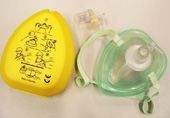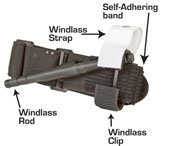September 21st, 2011 by Paul Auerbach, M.D. in Research
No Comments »

Once of the major recent advances in trauma care has been the evolution of topical substances that can be applied to wounds in order to limit or stop hemorrhage (bleeding). This is very important in wilderness medicine, because uncontrolled bleeding is a leading cause of death from injuries. When the bleeding site can be approached in such a manner as to stop the bleeding, then something very valuable may possibly be done for the patient.
In article entitled “Comparison of Celox-A, ChitoFlex, WoundStat, and Combat Gauze Hemostatic Agents Versus Standard Gauze Dressing in Control of Hemorrhage in a Swine Model of Penetrating Trauma,” Lanny Littlejohn, MD and colleagues used an animal model of a complex groin injury with a small penetrating wound, followed by completely cutting the femoral artery and vein, to determine whether there was any benefit to one or another hemostatic (stops bleeding) agent in comparison to each other and to standard gauze dressing. To cut to the chase (no pun intended), the results showed that no difference was found among the agents with respect to initial cessation of bleeding, rebleeding, and survival. In this study, WoundStat was inferior with respect to initial cessation of bleeding and survival when compared to Celox-A.
The authors point out how important it is to Read more »
This post, Article Compares Hemostatic Agents: Are There Any Differences?, was originally published on
Healthine.com by Paul Auerbach, M.D..
June 1st, 2011 by Paul Auerbach, M.D. in Health Tips, Research
No Comments »

 When a person performs cardiopulmonary (heart and lung) resuscitation (CPR), it is sometimes recommended to provide rescue breathing. This is certainly the case when the primary cause of the victim’s difficulty relates to failure to breathe adequately, such as with a drowning episode. When CPR first arrived on the landscape, laypersons were trained to perform mouth-to-mouth breathing (for adults) or mouth-to-mouth and nose breathing (for infants and small children).
When a person performs cardiopulmonary (heart and lung) resuscitation (CPR), it is sometimes recommended to provide rescue breathing. This is certainly the case when the primary cause of the victim’s difficulty relates to failure to breathe adequately, such as with a drowning episode. When CPR first arrived on the landscape, laypersons were trained to perform mouth-to-mouth breathing (for adults) or mouth-to-mouth and nose breathing (for infants and small children).
Following growing concern about transmission of diseases from blood and body fluids, laypersons were introduced to using masks or something similar to allow them to provide breathing assistance (“artificial respiration,” “artificial ventilation,” “rescue breathing,” etc.) to non-breathing persons. Masks have been used for decades by professional rescuers for ventilating patients, often in conjunction with the use of bags in a “bag-valve-mask” configuration. The valve between the mask and bag provides for one-way flow and prevents the backwash of vomitus, blood, liquid from the lungs, or other fluids that might diminish the effectiveness of the technique.
A number of excellent masks and face shields are available on the market for rescuers to be able to (relatively) safely blow air into a victim’s lungs. One example is Read more »
This post, CPR: Mouth-to-Mouth Breathing May Have Some Advantages Over Mask-Assisted Breathing, was originally published on
Healthine.com by Paul Auerbach, M.D..
May 23rd, 2011 by Paul Auerbach, M.D. in Health Tips
1 Comment »


The Combat Application Tourniquet Dr. Brad Bennett provided an excellent workshop at the 2010 Wilderness Medical Society annual meeting in Snowmass, Colorado on how to manage severe bleeding, based on his work with the Committee on Tactical Combat Casualty Care. From time to time,
wilderness medicine practitioners encounter situations of severe bleeding, so this information is essential for anyone responsible for the health and safety of outdoor explorers and adventurers.
In a simple algorithm, we learned that the first attempt to control bleeding is almost always direct hand pressure. This is followed by application of a pressure bandage. If that is successful, the victim then is evacuated. If the pressure bandage does not adequately control bleeding on the torso of the victim, then a hemostatic (stops bleeding) substance is applied prior to evacuation. If bleeding from an arm or leg threatens the victim’s life, a tourniquet may be required. A hemostatic agent that is being used with increasing frequency is QuikClot Combat Gauze. Tourniquets include the Combat
Application Tourniquet (“C-A-T”). Using any of these modalities requires instruction and preparation. Read more »
This post, How To Stop Bleeding: The Combat Application Tourniquet And QuikClot, was originally published on
Healthine.com by Paul Auerbach, M.D..
April 18th, 2011 by Paul Auerbach, M.D. in Health Tips
No Comments »

 Wilderness medicine folks are often considered to be “gearheads.” That is, we love to try out new outdoor equipment, whether it is for our activities, search and rescue, or personal safety. Improvisation is important, but it’s better to have what you need, particularly if you can pack light and accomplish your mission without unnecessary bulk and weight. There are numerous suppliers of equipment online. From time to time, as I am made aware of these, I will let you know.
Wilderness medicine folks are often considered to be “gearheads.” That is, we love to try out new outdoor equipment, whether it is for our activities, search and rescue, or personal safety. Improvisation is important, but it’s better to have what you need, particularly if you can pack light and accomplish your mission without unnecessary bulk and weight. There are numerous suppliers of equipment online. From time to time, as I am made aware of these, I will let you know.
Rescue Essentials is a frequent exhibitor at wilderness medicine continuing medical education meetings, and so I have become familiar with their carried product lines.
Importantly, Rescue Essentials carries the complete product line for SAM
Medical Products, which include the SAM Splint series and BlistOBan blister
(prevention) bandages. The company sells equipment for persons who respond to outdoor medicine situations, tactical medics, search and rescue personnel, and wilderness emergency medical technicians.
As a reminder of what a layperson might need to consider carrying in order to be prepared to assist a person outdoors in need of medical attention, here is a list that appears in the 5th edition of Medicine for the Outdoors. From this list, one would select the desired items: Read more »
This post, Emergency Rescue Essentials: The Outdoor Gear You Need, was originally published on
Healthine.com by Paul Auerbach, M.D..
March 6th, 2011 by Paul Auerbach, M.D. in Better Health Network, Health Tips
No Comments »

 This is a guest post by Dr. Erik McLaughlin.
This is a guest post by Dr. Erik McLaughlin.
**********
Traveler’s Diarrhea: The Basics
Known around the world by many names including “Montezuma’s revenge,” “Delhi belly” and “mummy tummy,” traveler’s diarrhea (TD) is the most common illness faced by travelers. Nothing can slow down a fun trip as easily as TD — and it can also have serious health implications. TD typically lasts four to six days, and 90 percent of cases occur within the first two weeks of travel.
Anatomy You Need to Know
The gastrointestinal tract starts at the mouth and ends at the anus. After food enters the mouth, it passes through the esophagus to the stomach, where it sits for approximately 45 minutes. After being broken down by gastric secretions, food matter enters the small intestine (duodenum, jejunum, and ileum in order). The small intestine is the site where most nutrients are absorbed by the body. From the small intestine, food matter begins to look more like feces as it progresses to the large intestine or colon. The colon absorbs water from the food material before the material passes through the anus and exits the body as feces.
Symptoms
Recognizing the warning signs of TD, such as blood in the stool, fever, or abdominal cramping, can help a savvy traveler know when to seek medical help.
TD has many definitions; the presence of three or more loose-formed stools in one day is a good one. Abdominal cramping, nausea, vomiting and fever may also occur. The presence of blood in the stool can indicate that infection has directly damaged the intestinal wall and should be taken seriously. Read more »
This post, Traveler’s Diarrhea: The Basics, was originally published on
Healthine.com by Paul Auerbach, M.D..



 When a person performs cardiopulmonary (heart and lung) resuscitation (CPR), it is sometimes recommended to provide rescue breathing. This is certainly the case when the primary cause of the victim’s difficulty relates to failure to breathe adequately, such as with a drowning episode. When CPR first arrived on the landscape, laypersons were trained to perform mouth-to-mouth breathing (for adults) or mouth-to-mouth and nose breathing (for infants and small children).
When a person performs cardiopulmonary (heart and lung) resuscitation (CPR), it is sometimes recommended to provide rescue breathing. This is certainly the case when the primary cause of the victim’s difficulty relates to failure to breathe adequately, such as with a drowning episode. When CPR first arrived on the landscape, laypersons were trained to perform mouth-to-mouth breathing (for adults) or mouth-to-mouth and nose breathing (for infants and small children).
 Wilderness medicine folks are often considered to be “gearheads.” That is, we love to try out new outdoor equipment, whether it is for our activities, search and rescue, or personal safety. Improvisation is important, but it’s better to have what you need, particularly if you can pack light and accomplish your mission without unnecessary bulk and weight. There are numerous suppliers of equipment online. From time to time, as I am made aware of these, I will let you know.
Wilderness medicine folks are often considered to be “gearheads.” That is, we love to try out new outdoor equipment, whether it is for our activities, search and rescue, or personal safety. Improvisation is important, but it’s better to have what you need, particularly if you can pack light and accomplish your mission without unnecessary bulk and weight. There are numerous suppliers of equipment online. From time to time, as I am made aware of these, I will let you know.








